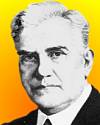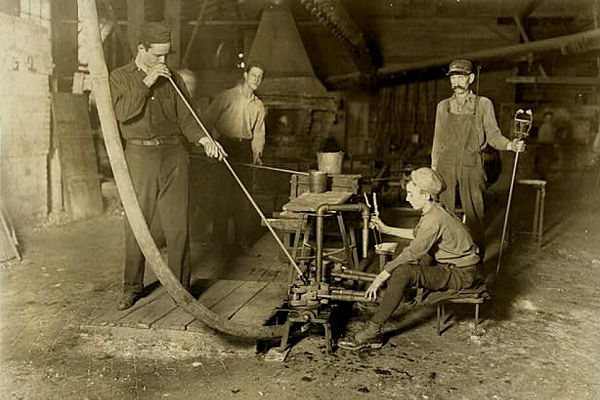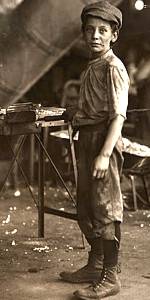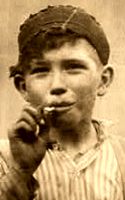 (source)
(source)
|
Michael Owens
(1 Jan 1859 - 27 Dec 1923)
American inventor and manufacturer who invented the automatic glass-blowing machinery for making bottles, that revolutionized the industry, and furthermore eliminated child labor from glass-bottle factories. In 1903, he formed the Owens Bottle Machine Company, and by the next year he had patents on a machine that could produce four bottles per second.
|
[Introduction: To a large degree, with his new glass bottle manufacturing technology, Michael Owens revolutionized the American diet as well as the glass industry by allowing for better storage and preservation of foods. His automatic bottle-making machine could easily produce bottles every second, compared to a hardworking glassblower, whose rate was one per minute. These new high production rates changed forever the beer-making, food, and soft-drink industries.1
In 1913, the Owens Company received a letter from the National Child Labor Committee of New York, commending the Owens machine for its major role in the elimination of child labor.1
Throughout various industries in the U.S., exploitation of child labor2 expanded with the industrial revolution, and still existed in the early twentieth century, but union organizing and child labor reform also grew from as early as the early 1870s. The National Child Labor Committee, was formally organized on 25 Apr 1904, advocating for child labor reform at the state level, with the mission of “promoting the rights, awareness, dignity, well-being and education of children and youth as they relate to work and working.”3 Eventually, the national Fair Labor Standards Act was passed by the U.S. Congress on 24 May 1938.4
Michael Owens fully understood the significance of his machines eliminating child labor in the glass industry, because he had first-hand experience himself, having been employed in glass bottle manufacturing from the age of ten. —Webmaster.]
Boy Labor in Glass-Bottle Factories.
A Woman’s Vivid Pen-Picture of Its Miserable Conditions—
An Industry That Is Fed with Children’s Lives.
from New York World (1903)
Writing in Charities (New York), Mrs. Florence Kelley graphically describes the hard conditions under which thousands of young boys are working in the glass-bottle factories of New Jersey, Pennsylvania, Ohio, Indiana and Illinois.
Mrs. Kelley says that a glass-blower in a bottle factory usually requires three boys to carry bottles from the moulder to the annealing oven. In some factories the blowers are required to furnish boys, and as they do not sacrifice their sons (whom they introduce into the trade as apprentices, if at all), they are continually searching for available sources of supply. For years the rumor refused to die out that certain charitable institutions of Philadelphia systematically furnished orphan boys who had reached the twelfth birthday to glass works in New Jersey, where the law, until this year, permitted boys to begin work at that tender age. These orphans were nominally adopted by glass-blowers, whose slaves they became. Within a year applications have been made to a philanthropist in New Jersey for young lads to be “adopted” by glass-blowers, who were required to furnish more boys than they could obtain.
The load of bottles which a boy carries at one time is not large or heavy, and there is no heavy lifting to be done. Hence such work is uniformly described by employers as “light and easy.” But the circumstances attending the work, the surroundings amid which it is done, fill such words with grim sarcasm. The speed required and the heated atmosphere render continuous trotting most exhausting. An hour’s steady trotting in pure air tires healthy school-boys of seven to fourteen years; but these little lads trot hour after hour, day after day, month after month, in heat and dust. There was no restriction, Mrs. Kelley declares, upon night work. Any child who was eligible for work at all—often by means of perjured affidavit of parent or guardian—was used indifferently by night or by day. The pitifully little children were found at work at 2 o’clock In the morning. On going out into the black, cold winter morning from the heat and glare of the glass ovens the boys went, as the men did, to the nearest saloons, to drink the cheap drinks sold, just across the street from the works. All the boys used tobacco, usually chewing It. They were stunted, illiterate, profane and obscene—wrecked in body and mind before entering upon the long adolescence known to happier children. The sharp contrast between the heat of the glass ovens and the frost of the winter morning produces rheumatism and affections of the throat and lungs, so that many of the boys die, before reaching the age of apprenticeship, from disease due directly to the circumstances attending their work, and more common elsewhere among adults than among children.
While the Illinois Legislature succeeded, last May, in enacting into law the bill prohibiting night work for children, the situation in the other States where the glass-bottle industry has a foothold is far less favorable.
Night work for children is not yet prohibited in Indiana or Pennsylvania, and in New Jersey glass works are expressly exempted from the law which prohibits the employment of women, and minors under eighteen years of age in manufacture after 6 o’clock at night. Thus, in Indiana and New Jersey, boys of fourteen years may legally be employed throughout the night in the glass works, and in Pennsylvania they may be so employed at the age of thirteen years.
That young children are thus employed is shown by the report of the State Factory Inspector of Indiana, who records thirteen prosecutions of glass manufacturers for violations of the child-labor law; while it is but a few months since a little boy in New Jersey, returning from his night’s work, fell asleep, exhausted, upon the tracks of the railway and was killed by a passing train.
In Pennsylvania, on February 27, 1903, the Western Pennsylvania Association of Glass Manufacturers held a meeting at Pittsburg, at which it denounced and ridiculed those sections of the child-labor bill pending before the Legislature of the State which required that children should be able to read and write simple sentences in the English language before beginning work, and should not be employed at night. The association appointed a committee to go to Harrisburg to oppose the passage of the bill, which accordingly failed to become a law.
Thus, Pennsylvania, Indiana and New Jersey still permit the glass industry to use up and wear out by night work little boys who are nominally thirteen and fourteen years of age, but are really of any age at which the employer finds them available. Evidently, the “child-eating ogre” needs the alert attention of the friends of working children in these States.

2 Some of the most powerful images in the history of documentary photography were taken by Lewis Wickes Hine, working for the NCLC.
3 National Child Labor Committee
4 Fair Labor Standards Act
In the second photo, John Tidwell is smoking outside Avondale Mills, a cotton mill in the Avondale neighborhood of Birmingham, Alabama. He worked there as a doffer, a job typically done by children. Photo by Lewis Hine (Nov 1910), in the LOC collection, with a note that “Many of these youngsters smoke”. —Webmaster]
- 1 Jan - short biography, births, deaths and events on date of Owens's birth.
- Michael J. Owens - short biography
- The Glass Industry and Child Labor Legislation - by Charles L. Chute (1911)
- Child Labor in the Glass Industry - by Owen R. Lovejoy (1906)
- Displacement of Labor by Machinery in the Glass Industry - Monthly Labor Review (Apr 1927) of U.S. Bureau of Labor Statistics
- Michael Owens and the Glass Industry, by Quentin Skrabec Jr. - book suggestion.






